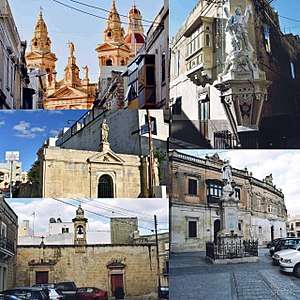Luqa
| Luqa Ħal Luqa Casal Luca | |||
|---|---|---|---|
| Local council | |||
 Clockwise from top left:Tower of the Parish Church of St Andrew, Dejma Cross, Neo-Baroque building, Tal-Ftajjar Chapel, and former British military building | |||
| |||
 | |||
| Coordinates: 35°51′35″N 14°29′21″E / 35.85972°N 14.48917°ECoordinates: 35°51′35″N 14°29′21″E / 35.85972°N 14.48917°E | |||
| Country |
| ||
| Region | Southern Region | ||
| District | Southern Harbour District | ||
| Borders | Birzebbuga, Għaxaq, Gudja, Kirkop, Marsa, Mqabba, Paola, Qormi, Safi, Santa Luċija, Siġġiewi, Tarxien, Zurrieq | ||
| Government | |||
| • Mayor | John Schembri (PL) | ||
| Area | |||
| • Total | 6.7 km2 (2.6 sq mi) | ||
| Population (March 2014) | |||
| • Total | 5,945 | ||
| • Density | 890/km2 (2,300/sq mi) | ||
| Demonym(s) | Ħalluqi (m), Ħalluqija (f), Ħalluqin (pl) | ||
| Time zone | UTC+1 (CET) | ||
| • Summer (DST) | UTC+2 (CEST) | ||
| Postal code | LQA | ||
| Dialing code | 356 | ||
| ISO 3166 code | MT-25 | ||
| Patron saint | St. Andrew | ||
| Day of festa |
First Sunday of July (main feast) 30 November (liturgical feast) | ||
| Website | Official website | ||
Luqa (Maltese: Ħal Luqa, meaning poplar) is a village located in the Southern Region of Malta, 4.3 km from the capital of Malta Valletta, near the Malta International Airport. It is an old town that has a dense population, typical of the Maltese Islands. The population of Luqa is 5,945 as of March 2014.[1] There is a church in its main square dedicated to St. Andrew.[2] The traditional feast of St. Andrew is celebrated on the first Sunday of July, with the liturgical feast being celebrated on the November 30.[3]
The famous clock maker and inventor Michelangelo Sapiano (1826-1912) used to live in Ħal Luqa. He constructed various kinds of clocks, the clock in the belfry of the Parish Church being one of his many works. The house in Ħal Luqa where he used to live is located on Pawlu Magri Street.[4]
History

Luqa was established as a separate Parish from that of Gudja on 15 May 1634 by a decree issued by Pope Urban VIII. In 1592 the village of Luqa was hit by Bubonic plague, which at that time hit all the population of Malta and caused many deaths. A sign of this sad episode is the cemetery found in Carmel Street, Alley 4 where people were buried in a field changed into a cemetery.
Another sad tragedy for Ħal Luqa was the cholera epidemic of 1850 where 13 people lost their lives. A cemetery is still present in Valletta Road as a reminder of this tragedy.
During the early 20th century Ħal Luqa took prominence because of the airport. The Royal Air Force established RAF Station Luqa, an airfield with runways which later on evolved as a civilian airport. The RAF established military and civilian buildings in the area close to the airfield/airport and in Ħal Farruġ. They used the airfield until it closed on 31 March 1979 when it was transferred to the Maltese Government to be transformed into a civilian airport. However they still used the domestic site for their own military force.
Many lives were lost during the Second World War in Luqa, and many buildings destroyed due to heavy bombardment. A tragedy which is still remembered happened on 9 April 1942 when a bomb hit a wartime shelter and a well and the people inside the shelter were buried alive. The Local Council still remembers the people who lost their lives during WWII with a ceremony of the laying of bay wreaths together with the other local organisations and clubs.
The patron Saint of Luqa is St. Andrew (Sant' Andrija). A local niche dedicated to him is found in Luqa, which is two storeys high.[5]
Governance
Citizens of Ħal Luqa vote for their local council every three years, which council consists of seven members, one of them being the mayor. The Mayor of Ħal Luqa is John Schembri.[6]
Economy
Air Malta and Medavia have their head offices at Malta International Airport in Luqa.[7][8]
Zones in Ħal Luqa
- Għammieri
- Ħal Farrug
- Ħal Luqa Industrial Estate
- Ta' Ħal Saflieni
- Taċ-Ċagħki
- Taċ-Ċawla
- Tal-Bandieri
- Wied Betti
- Wied il-Knejjes
- Xagħra tas-Simar
Demographics

References
- ↑ "Estimated Population by Locality 31st March, 2014". Government of Malta. 16 May 2014. Archived from the original on 21 June 2015.
- ↑ Mahoney, Leonardo (1996). 5,000 years of Architecture in Malta. Malta: Valletta Publishing. Format. p. 154. ISBN 9990958157. ISBN 9789990958157.
- ↑ Malta Annual Festivals Retrieved on 18 March 2010.
- ↑ No Man is an Island Archived 2013-05-10 at the Wayback Machine. Cuckoo Clock Information. Retrieved on 18 March 2010.
- ↑ "Archived copy". Archived from the original on 2016-08-04. Retrieved 2016-03-22.
- ↑ Official website
- ↑ "Contact Us." Air Malta. Retrieved on 23 April 2013. "Air Malta plc Level 2, Skyparks Business Centre Malta International Airport Luqa, Malta. LQA 9020"
- ↑ "Contact Us Archived 2012-07-29 at the Wayback Machine.." Medavia. Retrieved on April 23, 2013. "P.O. Box 48, Malta International Airport Luqa LQA 4000"
External links
| Wikimedia Commons has media related to Luqa. |

